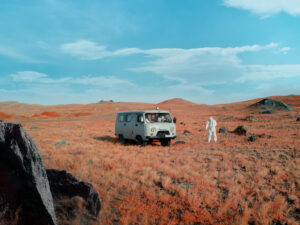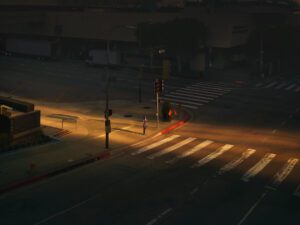Alia Ali (b. 1985) is a Yemeni-Bosnian-US multimedia artist recognised for challenging culturally sanctioned oppression and confronting notions of gender, politics, media and citizenship. Patterns and textiles are her main motif; she’s best known for making portraits in which cloth is used to conceal and camouflage the physical identities of figures, asking questions about how we define and separate through what we can or can’t see. What are the fabricated barriers in society that promote the idea of “us” and “them”? Her current exhibition at Gallery—Peter—Sillem, Frankfurt, sees Ali taking steps towards working with sculpture and installation, expanding her “Yemeni Futurism” project and engaging with pressing topics such as the politicisation of the body, the history of colonisation, imperialism, sexism and racism.
A: Tell us about how you got into working behind the lens – where did it all begin?
AA: My mother is a photographer and a translator. We travelled quite a bit as children and she would always give us disposable cameras. It was always fun seeing what came up after they were developed. Later in life, I looked at the photos and realised that they were telling me something – they were reflecting back to me what I was interested in. I wasn’t interested in people’s faces, or landscapes, I was always interested in colours and hands – taking photos of people’s hands and the things they were making. Today I look back and realise that I was more fascinated by the generations of knowledge and imagination that the hands carry, whether it was making food, fabrics, or even gestures as they would tell stories.
A: What’s the focus or message behind your latest exhibition at Galerie Peter Sillem?
AA: In the past years I’ve had a sense of stagnancy — with COVID and the stillness of time. That doesn’t mean that things stopped. Time moved, we moved, news moved and everything around us moved in our stillness. We began to listen, to see things that we never would really look at, to look inward. And then suddenly things started to pick up, like a pendulum shifting back and forth at extreme pace. At least that was my experience. Somehow the term that kept coming back was this notion of frequencies – that everything, even in its stillness, like a photograph, emits frequency.
Over the years, as I developed my practice, I would have conversations with visitors about their feelings or response to my work – many of which they couldn’t quite decipher but somehow moved them, one way or the other – for better or for worse. Regardless, I became interested in what was happening between the viewer and my artwork. To me it’s simple: both movement and stillness speak to each other through frequencies. I learned in the process that it’s not only sound that is measured by frequency, but, in fact, everything is. Every single thing, living and non-living, terrestrial and galactic, can be measured this way.


A: Do you have a favourite piece in the show?
AA: No. They are all special and, somehow, reuniting with them after making them in the studio is like visiting old friends. My favorite part is seeing them interact in various configurations. Furthermore, I always do a site-specific installation in my solo exhibitions as a way to identify the “now” and the “what’s to come”. It’s a way of reframing the gaze, where viewers are more than onlookers to the work. They become part of it. Hopefully, upon leaving, they will realise that the gaze was on them all along.
A: Who – or what – are your biggest inspirations?
AA: Hands. I have never been very intrigued by how people look. I was never drawn to what makes us different in our accents, the colour of our eyes, or the wrinkles on our faces – but I’ve always been drawn to people’s hands. I look at hands for all that they have made, the mastery they have accomplished over years of learning, and the centuries of ancestors before them who passed on that knowledge. The hands are essentially the vessels of one’s imagination, ideas and environment. I found that by looking at what people create, make or produce, we can see how similar we are, rather than focusing on differences.
A: What’s been the highlight of your career so far?
AA: The fact that I have a career as an artist.
A: Do you have a “signature” technique or approach? What is it?
AA: Acknowledge mistakes. Don’t fix them. Those are the moments when the rare and unique become visible and possible. Mistakes are a glitch. Normally we try to redirect ourselves to what is done, what has been tested and what is acceptable. However, mistakes offer the opportunity to explore enriching methods of making, new ways of being and fresh opportunities to create.
A: If you could do any other job, or be an expert in any other field, what would it be?
AA: An artist is a creative, and every “job” requires creativity. My work is to find creative ways to navigate all kinds of situations, spaces and ways of thinking.
A: Who are your favorite artists working right now?
AA: Cauleen Smith, Waleed Raad, Ashley Hunt, Jumana Mana, Ali Maimon.
A: Is there anything you hope audiences take away from the show?
AA: For me, the most powerful works are those that make me physically move around, and that also move me internally from the time I walk in to the time I walk out – manifesting as curiosity, disturbance, knowledge or shared experience. This is what I hope to achieve for my visitors.
A: What are you working on right now? Anything for us to look forward to?
AA: Yemeni Futurism has been something I have been developing for some years now. Finally it’s making its way into the world. You can learn more about it here.
galerie-peter-sillem.com | Until 16 December
Image Credits:
1. Alia Ali, Dreamer, Pigment Print, mounted, framed with Rajasthani hand-printed cotton, 117 x 167.5 x 7.5 cm, edition of 3 + 2 AP © Alia Ali / courtesy Galerie—Peter—Sillem
2. Alia Ali, Serpentine, 2023.
3. Alia Ali, Drown in My Eyes of Poppy Fields, Pigment Print, mounted, framed with Rajasthani hand-printed cotton, 167.5 x 117 x 7.5 cm, edition of 3 + 2 AP © Alia Ali / courtesy Galerie—Peter—Sillem





